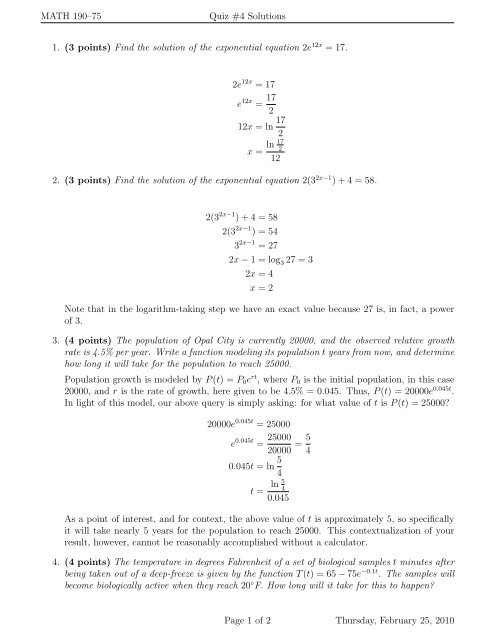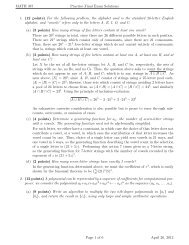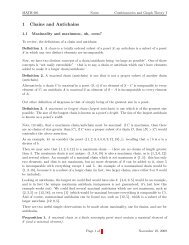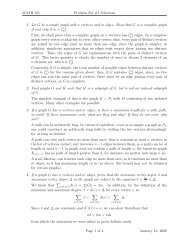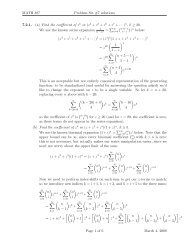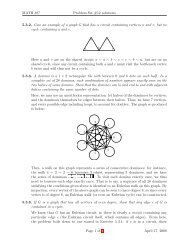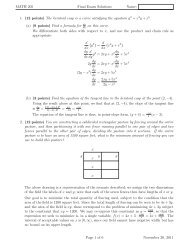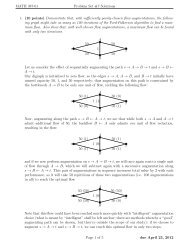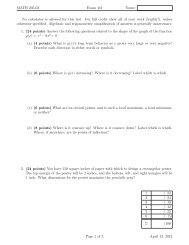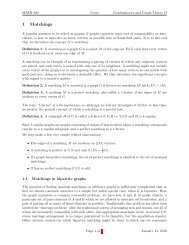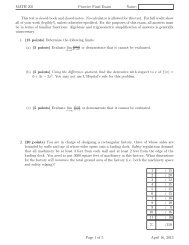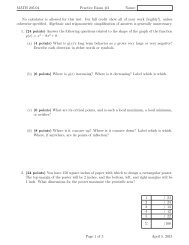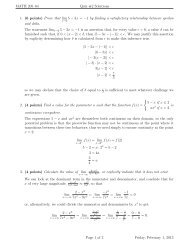MATH 190â75 Quiz #4 Solutions 1. (3 points) Find the solution of the ...
MATH 190â75 Quiz #4 Solutions 1. (3 points) Find the solution of the ...
MATH 190â75 Quiz #4 Solutions 1. (3 points) Find the solution of the ...
You also want an ePaper? Increase the reach of your titles
YUMPU automatically turns print PDFs into web optimized ePapers that Google loves.
<strong>MATH</strong> 190–75<br />
<strong>Quiz</strong> <strong>#4</strong> <strong>Solutions</strong><br />
<strong>1.</strong> (3 <strong>points</strong>) <strong>Find</strong> <strong>the</strong> <strong>solution</strong> <strong>of</strong> <strong>the</strong> exponential equation 2e 12x = 17.<br />
2e 12x = 17<br />
e 12x = 17<br />
2<br />
12x = ln 17<br />
2<br />
x = ln 17 2<br />
12<br />
2. (3 <strong>points</strong>) <strong>Find</strong> <strong>the</strong> <strong>solution</strong> <strong>of</strong> <strong>the</strong> exponential equation 2(3 2x−1 ) + 4 = 58.<br />
2(3 2x−1 ) + 4 = 58<br />
2(3 2x−1 ) = 54<br />
3 2x−1 = 27<br />
2x − 1 = log 3 27 = 3<br />
2x = 4<br />
x = 2<br />
Note that in <strong>the</strong> logarithm-taking step we have an exact value because 27 is, in fact, a power<br />
<strong>of</strong> 3.<br />
3. (4 <strong>points</strong>) The population <strong>of</strong> Opal City is currently 20000, and <strong>the</strong> observed relative growth<br />
rate is 4.5% per year. Write a function modeling its population t years from now, and determine<br />
how long it will take for <strong>the</strong> population to reach 25000.<br />
Population growth is modeled by P (t) = P 0 e rt , where P 0 is <strong>the</strong> initial population, in this case<br />
20000, and r is <strong>the</strong> rate <strong>of</strong> growth, here given to be 4.5% = 0.045. Thus, P (t) = 20000e 0.045t .<br />
In light <strong>of</strong> this model, our above query is simply asking: for what value <strong>of</strong> t is P (t) = 25000?<br />
20000e 0.045t = 25000<br />
e 0.045t = 25000<br />
20000 = 5 4<br />
0.045t = ln 5 4<br />
t = ln 5 4<br />
0.045<br />
As a point <strong>of</strong> interest, and for context, <strong>the</strong> above value <strong>of</strong> t is approximately 5, so specifically<br />
it will take nearly 5 years for <strong>the</strong> population to reach 25000. This contextualization <strong>of</strong> your<br />
result, however, cannot be reasonably accomplished without a calculator.<br />
4. (4 <strong>points</strong>) The temperature in degrees Fahrenheit <strong>of</strong> a set <strong>of</strong> biological samples t minutes after<br />
being taken out <strong>of</strong> a deep-freeze is given by <strong>the</strong> function T (t) = 65 − 75e −0.1t . The samples will<br />
become biologically active when <strong>the</strong>y reach 20 ◦ F. How long will it take for this to happen?<br />
Page 1 <strong>of</strong> 2 Thursday, February 25, 2010
<strong>MATH</strong> 190–75<br />
<strong>Quiz</strong> <strong>#4</strong> <strong>Solutions</strong><br />
Here we are provided with <strong>the</strong> model, and simply asked when <strong>the</strong> modeled quantity is equal to<br />
20 ◦ ; in o<strong>the</strong>r words, we are asked for which value <strong>of</strong> t it is true that T (t) = 20. Plugging this<br />
into <strong>the</strong> known formula for T (t):<br />
65 − 75e −0.1t = 20<br />
−75e −0.1t = −45<br />
e −0.1t = −45<br />
−75 = 3 5<br />
−0.1t = ln 3 5<br />
t = ln 3 5<br />
−0.1<br />
As a point <strong>of</strong> interest, and for context, <strong>the</strong> above value <strong>of</strong> t is approximately 5.1, so specifically<br />
it will take slightly more than 5 minutes for <strong>the</strong> samples to become biologically active.<br />
This contextualization <strong>of</strong> your result, however, cannot be reasonably accomplished without a<br />
calculator.<br />
5. (3 <strong>points</strong>) <strong>Find</strong> <strong>the</strong> reference number and terminal point for t = 7π 3 .<br />
Writing <strong>the</strong> coefficient <strong>of</strong> π as a mixed number, we see that t = ( 2 3) 1 π. Since <strong>the</strong> nearest<br />
multiple <strong>of</strong> 2 to 2 1 is 2 itself, we get a reference number <strong>of</strong> ˆt = ( 2 1 − 2) π = π . This terminal<br />
3 3 3<br />
point, since it is between 0 and π , is in <strong>the</strong> first quadrant, so its coordinates will be positive. The<br />
2<br />
specific coordinates associated ( with this reference number we know (from our set <strong>of</strong> significant<br />
1<br />
reference numbers) to be , √ )<br />
3<br />
.<br />
2 2<br />
6. (3 <strong>points</strong>) <strong>Find</strong> <strong>the</strong> reference number and terminal point for t = −41π .<br />
4<br />
Writing <strong>the</strong> coefficient <strong>of</strong> π as a mixed number, we see that t = ( −10 4) 1 π. Since <strong>the</strong> nearest<br />
multiple <strong>of</strong> 2 to −10 1 is −10, we get a reference number <strong>of</strong> ˆt = ( −10 1 − (−10)) π = −π.<br />
This<br />
4 4 4<br />
terminal point, since it is between − π and 0, is in <strong>the</strong> fourth quadrant, so its x-coordinate<br />
2<br />
will be positive and its y-coordinate negative. The specific coordinates associated ( √2<br />
with)<br />
this<br />
reference number we know (from our set <strong>of</strong> significant reference numbers) to be .<br />
, −√ 2<br />
2 2<br />
Anyone who believes exponential growth can go on forever in a finite world is ei<strong>the</strong>r<br />
a madman or an economist.<br />
—Kenneth Boulding<br />
Page 2 <strong>of</strong> 2 Thursday, February 25, 2010


